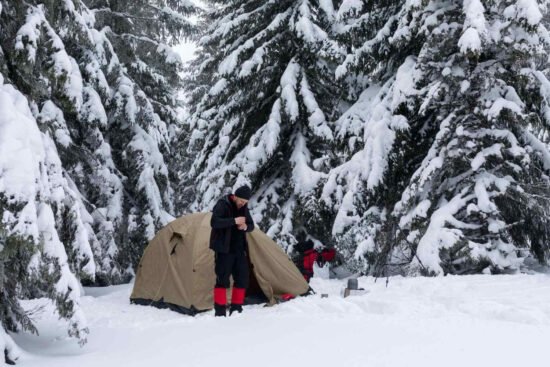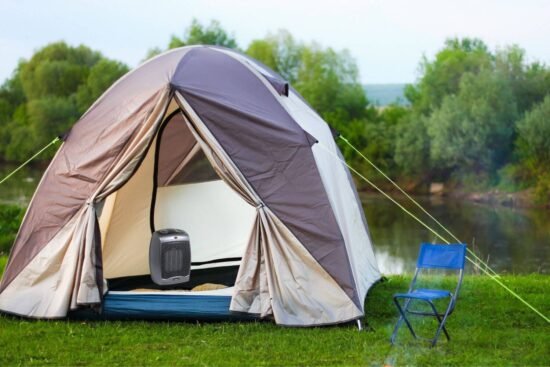Best Tent for Desert Camping: Setting the Stage
Best Tent for Desert Camping is an exhilarating adventure that offers unique challenges and breathtaking landscapes. From the vast sand dunes to the mesmerizing starry nights, camping in the desert requires specialized gear to ensure comfort and safety. One of the most crucial pieces of equipment for a successful desert camping trip is your tent. This guide will help you understand what makes a tent ideal for desert camping and review the top 5 tents for this purpose. Whether you are a seasoned camper or a novice, understanding the nuances of desert camping will enhance your experience and ensure a safe and enjoyable trip.
What Makes a Tent Ideal for Desert Camping?
Choosing the best tent for desert camping involves considering several key factors:
Size
The size of your tent should accommodate your camping party comfortably while allowing for some extra space to store gear. Desert camping often involves longer stays, so having a tent that offers sufficient living space is crucial. If you’re car camping or setting up a base camp, larger tents like cabin tents or bell tents might be more suitable. These tents provide ample space and can often accommodate camping cots or air mattresses. For backpacking, opt for lightweight, compact tents that are easy to carry. Look for tents that provide a good balance between interior space and portability.
Weight
Since desert camping often involves long hikes and rugged terrain, the weight of your tent matters. Lightweight backpacking tents are ideal for those who need to carry their gear over long distances. However, if you’re driving to your campsite, you can afford to bring a heavier, more spacious tent. Heavier tents often provide better durability and weather resistance, which can be beneficial in harsh desert conditions. Balancing weight and durability is key to choosing the right tent for your needs.
Material
The material of your tent significantly impacts its durability and performance in desert conditions. Consider tents made from:
- Canvas: Provides excellent insulation and durability but is heavier. Canvas tents are ideal for extended stays and base camps due to their robustness and ability to handle extreme conditions. They are also more resistant to UV damage compared to synthetic materials.
- Nylon or Polyester: Lighter and more breathable but may need a rainfly for additional protection. These materials are more suited for backpacking due to their light weight and compactness. They are also quicker to dry if they get wet from dew or unexpected rainfall.
Ventilation
Proper ventilation is crucial in desert environments where temperatures can soar during the day and drop at night. Look for tents with mesh windows, vents, and double-wall designs to enhance airflow and keep your tent cool. Adequate ventilation helps to prevent condensation build-up inside the tent, which can lead to discomfort and potential health issues. Mesh panels allow for airflow while keeping insects out, and well-placed vents help to regulate the temperature inside the tent.
Additional Considerations
- Ease of Setup: In the desert, you may encounter strong winds or shifting sands. A tent that is easy to set up and secure quickly is a valuable asset. Look for tents with intuitive designs and clear instructions.
- Durability: The harsh desert environment can be tough on equipment. A tent made from high-quality materials with reinforced stitching and durable poles will last longer and provide better protection.
- Weather Resistance: While deserts are typically dry, flash floods can occur. A tent with a good waterproof rating and a sturdy rainfly can protect you from unexpected weather events.
Top 5 Tents for Desert Camping: A Detailed Review
Here are five top-rated tents that excel in desert camping conditions, complete with their features, pros, and cons.
1. Kodiak Canvas Flex-Bow Tent
Features:
- Made from 100% cotton duck canvas
- Spacious design with a 6’6″ ceiling height
- Two large D-shaped doors with #10 YKK zippers
- Four large windows with no-see-um mesh
- Flex-bow frame for quick setup
Pros:
- Excellent durability and breathability
- Great ventilation with multiple windows
- Easy to set up and very spacious
- Sturdy construction can withstand harsh desert conditions
Cons:
- Heavier and bulkier compared to nylon tents
- Higher price point
The Kodiak Canvas Flex-Bow Tent is a top choice for those who prioritize durability and comfort. The canvas material offers excellent insulation, keeping the tent cooler during the day and warmer at night. The tent’s design allows for plenty of airflow, and its robust construction can handle the strong winds often encountered in desert environments. While it is heavier and more expensive, its longevity and performance make it a worthwhile investment for serious desert campers.
Learn more about the Kodiak Canvas Flex-Bow Tent here.
2. Coleman Sundome Tent
Features:
- Available in 2, 4, and 6-person sizes
- Made from durable polyester fabric
- Large windows and ground vents for ventilation
- Easy setup with continuous pole sleeves
- WeatherTec system with patented welded floors and inverted seams
Pros:
- Affordable pricing
- Good ventilation with large windows and ground vents
- Easy and quick setup
- Weather-resistant features
Cons:
- Not as durable as canvas tents
- Limited interior height
The Coleman Sundome Tent is a great option for those on a budget. It offers good ventilation and is easy to set up, making it ideal for short trips and novice campers. The WeatherTec system provides decent protection against unexpected rain, and the tent’s lightweight design is easy to transport. However, its polyester fabric may not be as durable in harsh desert conditions compared to canvas tents, and the limited interior height can be a drawback for taller campers.
Learn more about the Coleman Sundome Tent here.
3. MSR Hubba Hubba NX 2-Person Tent
Features:
- Lightweight, made from ripstop nylon
- Two large doors and vestibules for easy access
- Rainfly with roll-up vestibule stargazer view
- Adjustable, cross-ventilating rainfly vents
- Unified hub-and-pole system with color-coded clips
Pros:
- Ultra-lightweight, perfect for backpacking
- Excellent ventilation features
- Compact and easy to pack
- High-quality construction with good weather resistance
Cons:
- Smaller interior space
- Higher price for a two-person tent
The MSR Hubba Hubba NX is ideal for backpackers who need a lightweight, reliable tent. Its design includes features that enhance ventilation and ease of use, such as the adjustable rainfly and color-coded setup system. The tent’s compact size makes it easy to carry, and its durable materials provide good protection against the elements. While it is more expensive and offers less interior space, its performance and portability make it an excellent choice for desert backpacking.
Learn more about the MSR Hubba Hubba NX here.
4. Gazelle T4 Plus Hub Tent
Features:
- Pop-up design for easy setup
- Made from durable polyester material
- Large mesh windows and doors for ventilation
- Built-in awning and gear loft
- Two-room design with removable floor
Pros:
- Quick and easy setup
- Spacious with additional gear storage options
- Great ventilation with large mesh windows
- Durable construction
Cons:
- Heavier compared to other tents
- Takes up more space when packed
The Gazelle T4 Plus Hub Tent is perfect for family or group camping. Its pop-up design allows for a quick and easy setup, and the two-room configuration offers plenty of space and privacy. The large mesh windows provide excellent ventilation, making it comfortable even in hot desert conditions. Its robust construction can handle strong winds and sandy environments, but its heavier weight and bulkier size might be a drawback for those who need to carry it over long distances.
Learn more about the Gazelle T4 Plus Hub Tent here.
5. Shiftpod 2
Features:
- Made from weather-resistant composite fabric
- Insulated for extreme temperature variations
- Reflective material to keep the interior cool
- Multiple doors and vents for airflow
- Quick and easy setup
Pros:
- Excellent insulation for temperature control
- Quick and easy setup
- Reflective material helps keep the tent cool
- Durable and weather-resistant
Cons:
- Expensive
- Bulky and heavy
The Shiftpod 2 is designed for extreme conditions, making it an excellent choice for desert camping. Its insulated, weather-resistant fabric and reflective exterior help maintain a comfortable interior temperature. The tent’s design includes multiple doors and vents for optimal airflow, and its quick setup is a significant advantage in challenging environments. However, its high price and bulkier size may not be suitable for all campers, especially those on a budget or needing a more portable option.
Learn more about the Shiftpod 2 here.
The Importance of Ventilation in Desert Tents
Ventilation is a critical factor in desert camping due to the extreme temperature fluctuations. Proper airflow can mitigate condensation, keep the interior cool during the day, and provide comfort during warm nights. A well-ventilated tent helps prevent the build-up of moisture and reduces the risk of mold and mildew, which can be harmful to your health and damage your gear.
How to Enhance Airflow: Design, Positioning, and Accessories
- Mesh Panels: Choose tents with plenty of mesh panels to promote airflow. These panels allow hot air to escape and cooler air to circulate, maintaining a more comfortable temperature inside the tent.
- Tent Positioning: Set up your tent to face the prevailing winds, which can help with natural ventilation. Positioning your tent strategically can significantly enhance airflow and improve comfort.
- Accessories: Use tarps and shades to create additional shelter and reduce direct sunlight. Ventilation accessories like battery-operated fans can also help maintain airflow inside the tent. Reflective tarps or shades can deflect heat away from your tent, keeping it cooler during the hottest parts of the day.
Tent Maintenance in Harsh Environments: Tips and Tricks
Maintaining your tent in the desert involves protecting it from sand, wind, and sun damage. Here are some tips to keep your tent in top condition:
Protecting Against Sand
- Ground Tarps: Use a ground tarp to prevent sand from entering your tent. A tarp provides a barrier between the ground and your tent, reducing wear and tear on the tent floor and keeping sand out.
- Zipper Care: Keep zippers clean and lubricated to prevent sand from causing jams. Regularly clean the zippers with a brush and apply a silicone-based lubricant to keep them functioning smoothly.
Wind Protection
- Stake Securely: Use heavy-duty stakes and guy lines to secure your tent against strong winds. Ensure the stakes are driven deep into the ground and the guy lines are taut to prevent the tent from shifting or collapsing.
- Low Profile: Opt for tents with a lower profile to reduce wind resistance. Tents that sit closer to the ground are less likely to be affected by strong winds, providing greater stability and security.
Sun Damage
- UV-Protective Spray: Apply UV-protective spray on your tent fabric to prevent sun damage. This spray can extend the life of your tent by protecting the material from the sun’s harmful rays.
- Shade: Set up your tent in shaded areas or use a reflective tarp to shield it from direct sunlight. Positioning your tent in the shade or using a reflective tarp can significantly reduce the interior temperature and protect the fabric from UV damage.
Additional Tips for Desert Camping
- Stay Hydrated: The dry desert environment can lead to dehydration quickly. Always carry plenty of water and drink regularly.
- Wear Appropriate Clothing: Lightweight, breathable clothing that covers your skin can protect you from the sun and help keep you cool.
- Plan for Temperature Fluctuations: Deserts can be extremely hot during the day and cold at night. Bring appropriate sleeping gear and clothing to stay comfortable.
- Be Prepared for Wildlife: Be aware of local wildlife and take precautions to keep your campsite safe from animals.
- Leave No Trace: Practice responsible camping by cleaning up your campsite and packing out all trash.
Conclusion: Choosing Your Perfect Tent for the Desert
Selecting the best tent for desert camping involves considering size, weight, material, and ventilation. Our top 5 reviews highlighted tents that excel in these areas, offering a range of options from lightweight backpacking tents to spacious canvas tents. Each tent has its strengths and is suited for different types of desert camping, whether you’re embarking on a solo backpacking trip or setting up a family base camp.
Remember, proper ventilation is crucial for comfort in the desert, and maintenance is key to ensuring your tent withstands harsh conditions. Armed with this knowledge, you’re well on your way to choosing the Best Tent for Desert Camping.
Happy camping, and may your desert explorations be filled with unforgettable experiences!





